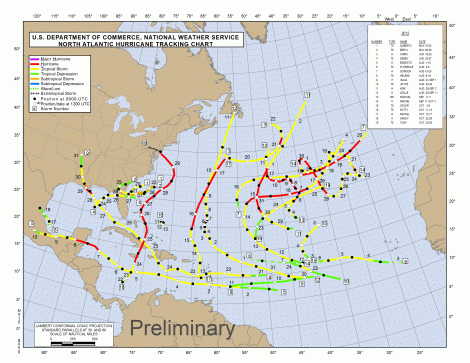Here, in just shy of four and a half minutes, is the entire 2012 hurricane season. Assuming, that is, that no tropical storms crop up in the next 36 hours or so; hurricane season ends on Nov. 30.
It’s pretty, in its way. Humbling, watching the patterns and the flow of the clouds as they work their way slowly around the ocean. For the planet, Sandy was just another spinning formation, made and gone and forgotten.
For us, Sandy was the capstone to what the Capital Weather Gang notes was tied for the third-most-active hurricane season in history.
In an average season (using 1981-2010 as a baseline), there are 12.1 named storms, 6.4 hurricanes, and 2.7 major hurricanes. This season ended up with 19 named storms, 10 of which became hurricanes, but just 1 of those became a major hurricane (defined as category 3 or higher on the Saffir-Simpson hurricane wind scale). The 19 named storms ties for the third greatest number of such storms in a season on record. Historically, only about 3 percent of seasons experience 19 or more named storms. As rare as this feat is, it was amazingly the third consecutive season to have 19 named storms!
Despite this year’s large number of named storms, major hurricane activity was minimal. Of all the seasons with at least 19 named storms, the previous lowest number of “major hurricane days” was 3.75. This year, the total was a meager 0.25 days (six hours).

NOAAEvery storm of 2012. Click to embiggen.
There’s another measure by which 2012 was exceptional.
Another metric for evaluating seasonal activity is known as Accumulated Cyclone Energy, or ACE. ACE is basically a wind energy index used to succinctly characterize a season by the intensity and duration of all of the storms. The 2012 season finished up at 126.2, or about 137 percent of an average season. The median value over the period 1951-2010 is 92.4, and any season that exceeds 103 is considered to be “above normal”; however, there must also be at least two major hurricanes to meet the “above normal” criteria. As of now, Michael is 2012’s only major hurricane, but it’s quite possible that Sandy will be upgraded to a major hurricane when it was near Cuba. Nadine, the fifth-longest-lasting storm on record, contributed to 20% of the total ACE, while Sandy contributed to 11% of the total.
So, in short, this year we had an extremely active and highly energetic hurricane season that resulted in billions of dollars of damage on the East Coast and the Caribbean.
If only there were something humans could do to lessen the amount of energy in the atmosphere and prevent future years of similar intensity.




